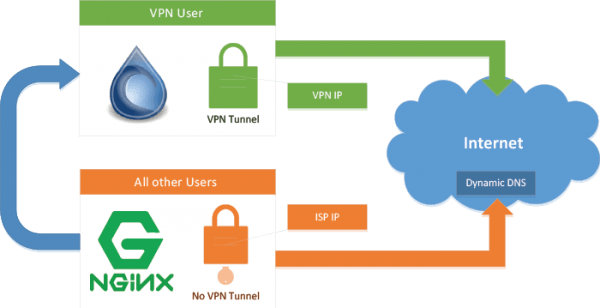![]() Our next guide in the VPN Split Tunnel sequence is Configure Deluge for VPN Split Tunneling on Debian 8 using systemd units. An excellent way of utilizing both the security that VPN connection provides and to still route only selected traffic over the VPN connection is called VPN Split Tunneling.
Our next guide in the VPN Split Tunnel sequence is Configure Deluge for VPN Split Tunneling on Debian 8 using systemd units. An excellent way of utilizing both the security that VPN connection provides and to still route only selected traffic over the VPN connection is called VPN Split Tunneling.
This is Part 2 of the VPN split tunnel guide, Part 1 can be found here where you prepare your server for VPN Split Tunneling. This tutorial shows you how to install Deluge on Debian 8 systemd system and run it under the vpn user created in Part 1 of the Split Tunnel guide. To access the Deluge Web UI you will need to use an nginx Reverse Proxy (even on local network).
| VPN Service | ||||
|---|---|---|---|---|
| Private Internet Access | ($3.33 / month) | |||
| Pure VPN | ($4.91 / month) | |||
| IPVanish | ($6.41 / month) |
Configure Debian 8 (including Minibian, Raspbian) for VPN Split Tunnel
You must complete Part 1: Force Torrent Traffic through VPN Split Tunnel Debian 8 + Ubuntu 16.04. If you have already configured Split Tunnel, then you can continue with this guide to install Deluge daemon. It is important that you have a working Split Tunnel on your server before you can proceed with installing Deluge for VPN Split Tunneling, otherwise it will not work!
Important: This guide is written for Debian 8 that uses systemd services, and it was tested to work on Minibian too. It might work on other Linux distributions, but it is guaranteed to work with PIA VPN on Debian 8. It will not work on Ubuntu 16.04 LTS as there a different systemd unit is required; if you are using Ubuntu 16.04 LTS, then use the guide specially written for Ubuntu 16.04 LTS. For Ubuntu Server 14.04 LTS, upstart scripts are required instead of systemd services. If you are using Ubuntu Server 14.04 LTS, jump to the Install and Configure Deluge VPN Split Tunneling Ubuntu 14.x guide.
Install Deluge and Web UI on Debian 8 (Minibian, Raspbian)
For Debian we need to use the Deluge version available in the official Debian repository. It might not be the latest version, as Debian is unfortunately quite slow to include latest versions in their repository. At the time of writing this guide, the final version is 1.3.13, while the the version in the Debian repository is 1.3.10. Most likely you are safe to use the version available from Debian. If you would like to use the latest version, you can build Deluge from source. More information available at Deluge's official page. Since Deluge is quite stable, I recommend you to use the version included in the Debian repository, unless you are an advanced user and comfortable to build Deluge on your own.
Note: on Debian 8 use su to change your identity to root, or you can install sudo and then execute all the commands that need root privileges with sudo. On Minibian the default login is root.
Update the repository and install the Deluge Daemon (deluged) and the Deluge Web UI (deluge-web)
apt-get update
apt-get install deluged deluge-web -yConfigure Deluge Logging
Both Deluge daemon and Deluge Web UI logs will be located at /var/log/deluge. You can't start Deluge daemon and Deluge Web UI until you configure the log directory and the permissions.
With the first line we create the required directory, with the second we modify ownership to user and group vpn, and with the third line we set the required permissions.
mkdir -p /var/log/deluge
chown -R vpn:vpn /var/log/deluge
chmod -R 770 /var/log/delugeNote: the chmod value 770 grants full access to the vpn user and to the members of the vpn group.
Finally, configure log rotation to properly maintain logs
nano /etc/logrotate.d/delugeInsert the following to rotate the logs
/var/log/deluge/*.log {
rotate 4
weekly
missingok
notifempty
compress
delaycompress
sharedscripts
postrotate
initctl restart deluged >/dev/null 2>&1 || true
initctl restart deluge-web >/dev/null 2>&1 || true
endscript
}Hit Ctrl + X, Y to Save and Exit.
Create Systemd Unit for Deluge Daemon and Web UI On Debian 8
One of the cool features of Deluge is that it allows you to run and control the daemon and the Web UI independently, even as different users.
If you want to retain direct access to the Web UI, then you need to run the Web UI service (attention: only the Web UI, not the daemon!) as your regular user, although I strongly recommend to run Web UI as vpn user and use nginx reverse proxy — we will follow this approach in this guide. The next step is to configure the Deluge daemon to run as the vpn user.
Create the Systemd Unit for Deluge Daemon
The user who will run Deluge daemon is the vpn user. Logs will be located at /var/log/deluge. We are using umask 007 value to grant full access to the user and members of the group the Deluge daemon is running as and prevents access for all other users. We will make sure Deluge is started after the tun0 interface is created to prevent accidental ip leaks.
When installing Deluge from Debian repository a systemd drop-in unit for Deluge daemon is created by default. We need to override the default settings.
First stop Deluge daemon
systemctl stop deluged.serviceThe create the required folder and conf file
mkdir -p /etc/systemd/system/deluged.service.d/
nano /etc/systemd/system/deluged.service.d/local.confand copy and paste the following
# [Unit]
# Description=Deluge Bittorrent Client Daemon
After=sys-devices-virtual-net-tun0.device
Wants=sys-devices-virtual-net-tun0.device
[Service]
Type=
Type=simple
User=
User=vpn
Group=
Group=vpn
UMask=007
ExecStart=
ExecStart=/usr/bin/deluged -d -l /var/log/deluge/daemon.log -L warning
Restart=
Restart=on-failure
# Configures the time to wait before service is stopped forcefully.
TimeoutStopSec=300
[Install]
WantedBy=multi-user.targetHit Ctrl + X, Y to save and exit.
Reload systemd to scan for new and changed units
systemctl daemon-reloadCreate the Systemd Unit for Deluge Web UI
We will create a separate systemd unit for Deluge Web UI. Unlike for the Deluge daemon, Debian doesn't provide a systemd drop-in for the Deluge Web UI. When the Deluge daemon is started or stopped, the Web UI is also started or stopped automatically. However, Deluge lets you control the Web UI separately using the systemd unit.
Create the Deluge Web UI systemd unit for Debian 8
nano /etc/systemd/system/deluge-web.serviceCopy and paste the following
[Unit]
Description=Deluge Bittorrent Client Web Interface
After=network-online.target sys-devices-virtual-net-tun0.device
Wants=sys-devices-virtual-net-tun0.device
[Service]
Type=simple
User=vpn
Group=vpn
UMask=027
ExecStart=/usr/bin/deluge-web -l /var/log/deluge/web.log -L warning
Restart=on-failure
[Install]
WantedBy=multi-user.targetHit Ctrl + X, Y to Save and Exit.
Enable the created service unit
systemctl enable deluge-web.serviceNote: at this stage both the Deluge Daemon and the Deluge Web UI systemd units are enabled to start on system startup, but until you restart the system for first time, you need to start them manually. I recommend to start them now to let Deluge create the required configuration files that we will need to edit further.
To start Deluge daemon
systemctl start deluged.serviceTo start Deluge Web UI
systemctl start deluge-web.serviceMake Deluge Web UI Auto Connect to Deluge Daemon
When you start the Deluge Web UI, after entering the password (default is deluge, I recommend to change it at first login) it will always prompt you to select the Deluge daemon you would like to connect to. This is because you can have more Deluge daemons running so this is where you can select to which Deluge daemon you would like to connect from the Web UI.
I assume that you are running one instance of Deluge daemon on your server, therefore it is preferred to configure auto connect. Of course, you will be able to access Deluge Web UI after you completed this guide and configured the nginx reverse proxy.
Note: Transdrone requires auto connect enabled to work – more on this in a later guide.
Stop Deluge daemon to edit the web.conf file
systemctl stop deluged.serviceMake sure the Web UI is also stopped
systemctl stop deluge-web.serviceEdit the created web.conf file
nano /home/vpn/.config/deluge/web.confFind the line
"default_daemon": "";and set it to
"default_daemon": "127.0.0.1:58846"Hit Ctrl + X, Y to Save and Exit.
Start Deluge daemon
systemctl start deluged.service
Make sure Web UI is also started
systemctl start deluge-web.serviceNow when you log into Deluge Web UI, it will automatically connect to the Deluge daemon.
Recommended Deluge Settings for Maximum Security
In order to make sure that none of the services included in Deluge are going to leak your IP address, I recommend to set the following settings. The following recommendations are based on many discussions on different forums.
In Deluge Web UI go to Preferences and Network tab. Disable all the Network Extras: UPnP, NAT-PMP, Peer Exchange, LSD, DHT, as you can see on the screenshot
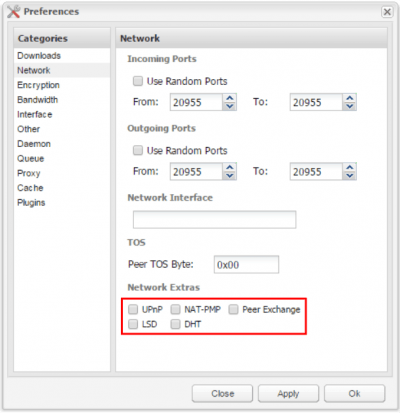
Next step is to proceed to Encryption tab, and make sure Encrypt entire stream is selected, and set the other settings as you can see on the screenshot below. This level of encryption is enough, especially when used over VPN that is already encrypted.
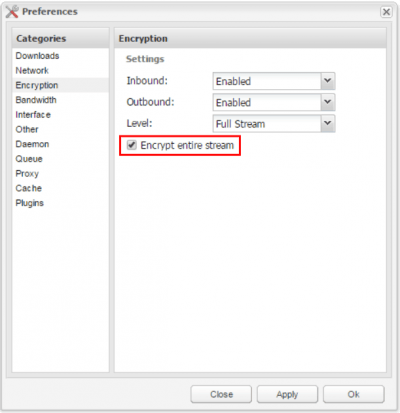
Note: when running Deluge over VPN connection there will be no open ports by default. This is fine if you don't need upload for private trackers or you don't want to make a larger contribution to common good as active seeder (please consider seeding to keep torrents alive). Opening ports for active connection decreases the security of the VPN connection in some extent, but it is still generally considered to be safe. PIA offers port forwarding on selected servers, stay tuned for a separate guide on how to configure Deluge with port forwarding and split tunnel VPN, we will add the link here when the guide is published!
Configure Deluge Remote Access with nginx Reverse Proxy
At this point you should have a fully working VPN with Split Tunneling and a running Deluge client tunneled over the VPN connection. To access Deluge Web UI you need to create a reverse proxy, you can't access the Web UI even from local network directly. The following part will show you how to configure nginx reverse proxy in less than five minutes. A very important note: this configuration uses plain, unencrypted http connection for nginx.
If you plan to access Deluge from outside of your local network you should consider configuring nginx with a secure SSL/TLS certificate using our guide Secure nginx Reverse Proxy with Let’s Encrypt, or alternatively you can configure with a self-signed certificate following the guide Enforce SSL for Secure nginx Reverse Proxy Linux (now that Let's Encrypt provides free valid certificates, I strongly recommend to use it).
If you need access to Deluge (or other services) only from your local network, then you can use the following simple nginx configuration.
Note: If you already have nginx installed and configured, just make sure you add the location part below marked with blue to your nginx virtual host file.
Update repository and install nginx
apt-get update
apt-get install nginx -yUnlink the default nginx virtual host
unlink /etc/nginx/sites-enabled/defaultCreate the nginx virtual host file
nano /etc/nginx/sites-available/reversePaste the nginx Deluge configuration and replace htpcguides.crabdance.com with your dynamic DNS address and 192.168.1.100 with the device’s local IP.
Usually for reverse proxy support we set a custom web root in the application itself but Deluge support setting a special header for the web root. Here the web root is deluge, it must match for the location and the X-Deluge-Base header.
This assumes Deluge is running on the same device as nginx, if it isn’t then change 127.0.0.1 to match the local IP address of Deluge.
If you already have an nginx reverse proxy virtual host you only need to add the location block marked with blue (do not copy the last } at the bottom)
server {
listen 80;
server_name htpcguides.crabdance.com 192.168.1.100;
location /deluge {
proxy_pass http://127.0.0.1:8112/;
proxy_set_header X-Deluge-Base "/deluge/";
}
}Ctrl+X, Y and Enter to save the deluge nginx reverse proxy virtual host
Symbolically link the virtual host so nginx will load it when the service is reloaded (if you already created a reverse virtual host, skip this step)
ln -s /etc/nginx/sites-available/reverse /etc/nginx/sites-enabled/reverseTest the nginx configuration is valid
nginx -tIf you got no errors then restart nginx
systemctl restart nginx.serviceMake sure Deluge is running
systemctl start deluged.serviceNow you can use your local IP address http://ip.address/deluge or dynamic DNS address at http://yourdns.address/deluge to access Deluge outside your home network. The default password for Deluge Web UI is deluge (strongly recommended to change it at first login).
Confirm Deluge Uses VPN Connection
Finally, we want to make sure that Deluge is using the VPN tunnel. A simple and reliable way to check this is to download a torrent file from TorGuard. They have a great service called Check My Torrent IP Address. To download the torrent file click on
Alternatively, you can Save Link Location (Firefox) or Copy link address (Chrome) and copy directly into Deluge's + Add URL field. The important part is the IP address under Tracker Status, marked with red. It should be the VPN server's IP address.
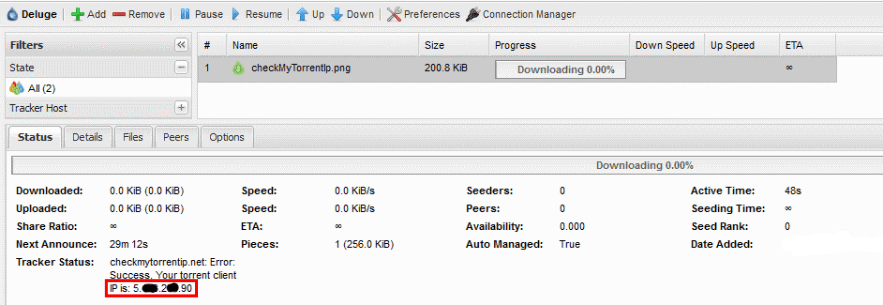
You can copy the IP address and check with IP Tracker. Just paste the IP address and the result should show you the location. Make sure it matches the VPN server's location you use (in our case it is Sweden).
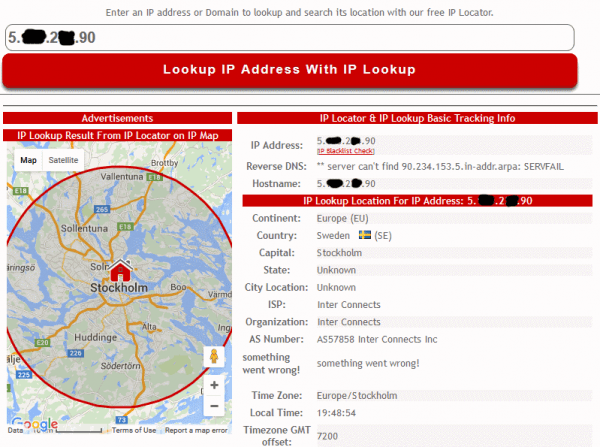
If the IP Lookup matches the VPN server’s location, you successfully configured Deluge for VPN Split Tunneling.
A final word on security (I know I mentioned this several times): if you configured nginx to be accessible from outside of the home network, make sure you use SSL/TLS and not plain http protocol. Let’s make the web a safer place by using the free SSL certificates!
Fix Permission Issues
In the VPN Split Tunnel guide we recommended to add your regular user to the vpn group, and to add vpn user to your regular user’s group. It is important to avoid any permission related issues with the downloaded torrents. We configured Deluge’s permissions for downloaded torrents to be fully accessible (read, write, execute) by vpn user and members of the vpn group.
If you use any automation tool like Sonarr or CouchPotato, the user who is running these services should be added to the vpn group. Make sure you add any users that run automation software to the vpn group like this by replacing user-running-automation.
usermod -aG vpn user-running-automation
